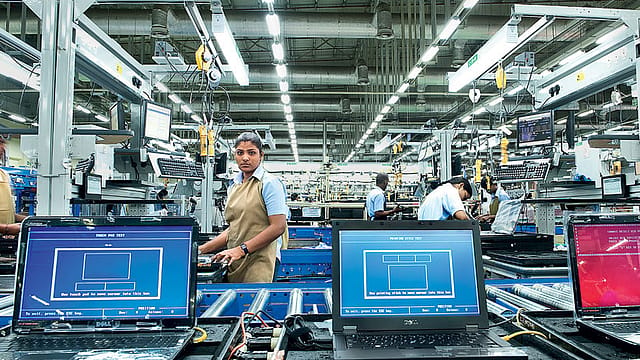India’s manufacturing PMI rises to a 26-month high in Dec 2022
ADVERTISEMENT

India's manufacturing sector activity, measured in purchasing manager's index (PMI), continued to expand in December 2022, rising to 57.8 from 55.7 in November, thanks to a robust improvement in the sector, which was the best since October 2020.
The December data shows a further increase in buying levels among goods producers. The rate of expansion for December was “historically sharp” and the “strongest” since May 2022, says S&P Global India Manufacturing PMI report, released today.
"The PMI average for the third fiscal quarter (56.3) was the highest recorded since one year ago," S&P said. The S&P indices vary between 0 and 100, with a reading above 50 indicating an overall increase compared to the previous month, and below 50 an overall decrease.
Pollyanna De Lima, economics associate director at S&P Global Market Intelligence, said after a promising start to 2022, the Indian manufacturing industry maintained a strong performance as time progressed. It wrapped the year with the best expansion in production seen since November 2021.
"Demand strength took centre stage among the reasons provided by firms for improvements in many measures. Additional materials were purchased and extra workers were hired as companies sought to supplement production and maintain healthy levels of inventories. Input stocks rose at a near-record pace," said De Lima.
January 2026
Netflix, which has been in India for a decade, has successfully struck a balance between high-class premium content and pricing that attracts a range of customers. Find out how the U.S. streaming giant evolved in India, plus an exclusive interview with CEO Ted Sarandos. Also read about the Best Investments for 2026, and how rising growth and easing inflation will come in handy for finance minister Nirmala Sitharaman as she prepares Budget 2026.
The economics associate director said less challenging supply-chain conditions also supported the upturn. "Delivery times were reportedly stable, which enabled firms to secure critical materials and boost their input stocks."
In her outlook, she said while some may question the resilience of the Indian manufacturing industry in 2023 amid a deteriorating outlook for the global economy, manufacturers are “strongly confident” in their ability to lift production from present levels.
The S&P India manufacturing index shows demand resilience boosted sales growth in December, with the rate of increase picking up to the quickest since February 2021. In some instances, the report finds that advertising, product diversification and favourable economic conditions supported sales.
The international demand for Indian goods also improved, though it was lesser than in November. Overall, the new orders from abroad rose at the “slowest pace” in five months as several companies struggled to secure new work from key export markets, the report said.
Suppliers to the manufacturing sector were comfortably able to accommodate the uptick in input demand, with average lead times unchanged from November.
To address backlogged work, Indian goods producers hired additional staff at the end of the year. The latest increase in employment was the 10th in consecutive months but the slowest since September. When assessing the year-ahead outlook for production, companies were optimistic. "Advertising and demand buoyancy was cited as the key opportunities to growth prospects," says the report.
Notably, the RBI in its latest Financial Stability Report said the strengthening of the economic recovery in Q3 FY23 is reflected in high-frequency indicators, especially those relating to the contact-intensive sectors. "India’s purchasing managers’ indices (PMI) for both manufacturing and services outperformed regional and global indices in October and November,” it said.
